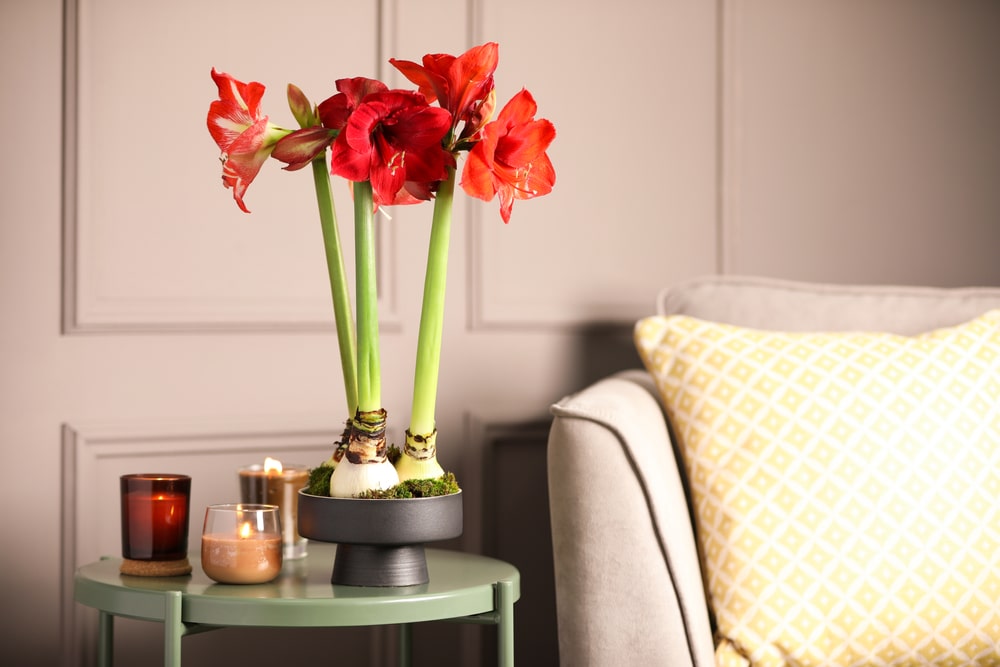The Amaryllis family—the Amaryllidaceae—is a wide and varied group, including the wild Amaryllis (Amaryllis Belladonna), our Christmas amaryllis (reclassified as Hippeastrum), as well as Narcissus (yes, daffodils!), tiny little snowdrops, agapanthus (Lily-of-the-Nile), alliums (onions, garlic, and ornamental onions), clivia, crinum (Cape Lilies) among others.
Most of these are bulbs needing a dormant period at some time during the year. For bulbs like daffodils and snowdrops they get their true dormancy during the summer—after the foliage dies down. For agapanthus and clivia, which those of us in temperate zones grow in containers, they get a semi-dormancy when we bring them inside for the winter, stop feeding them, and run them almost completely dry between waterings.
Now is the Time
Hippeastrum—Christmas amaryllis—are in now. So here’s how to grow these beautiful giants. Pot the bulb with the top third of the bulb exposed, in a pot about one to one and a half inches bigger around than the bulb. Water it when you are ready for it to start growing. It will take anywhere from six to about ten weeks, depending on the variety of amaryllis and the environment—bulbs in a cooler room will take a little bit longer. The bloom stalks are like “light meters”—pointing to the most light, so it’s best to keep them in a sunny window.
Let it Grow
To keep amaryllis from year to year is incredibly easy—I should know. I have 26 and rebloom them every year! So here’s how I do it. As soon as my amaryllis finished blooming, I cut the bloom stalk all the way back. If the amaryllis has not yet begun to grow leaves, it will very soon. I begin to fertilize—using African violet food (it is, after all, a blossom booster).
The first week of May, I move them outside for the summer (remember to let them get accustomed to direct outdoor sun gradually so as to avoid sunburn). Thereafter, I remember to stay on top of fertilizing and I let them grow all summer long. If you are the type that’s so busy you know you’ll forget to feed, it’s fine to use a slow-release fertilizer.
In the fall, I bring them in, allow them to go COMPLETELY dry and cut the leaves off, and then place the bulb in the pot in an attic, basement, closet, or attached garage for 10 weeks. After their ten week sleep, I repot any that need it, begin watering and wait to enjoy the show. The secret is feeding over the summer and giving them an eight to ten-week dormancy. If you do that, they’ll bloom for you year after year.
If you absolutely have to have them blooming during the holidays, put them into dormancy sometime from the middle of August to the first week in September.
I absolutely DON’T want mine blooming during Christmas. Between trying to keep cats from destroying the Christmas tree, all the running around, and poinsettias everywhere, I barely have enough time to notice them. I put mine to sleep mid-October and bring them out the first of January. That way, most of them bloom somewhere between late January or early February. Because I’m so not a winter fan, I appreciate their dramatic beauty so much more then.
When you pick out your amaryllis bulb, get the largest size for the variety. You can get amaryllis already potted in boxes for a quick gift but buying individual bulbs gives you a better selection. If you want to give amaryllis as a gift or you want one for yourself—of if you saved yours from last year and have questions, we can help!

